Leggy Seedlings: Why You Have Leggy Seedlings and How to Fix This Problem
INSIDE: Struggle with leggy seedlings? It’s a common problem. Often due to a lack of light. Read my article to shed light on simple fixes for healthier seedlings now.
A couple of weeks after sowing your seeds indoors, your shoulders sag as you peer at your seedlings.
They don’t look right.
They’re thin, pale, wispy things – all skinny stems and hardly any leaves. It feels like a seed-starting disaster!
And you wonder, “Can I salvage these seedlings?”
I can tell you from experience it is possible to fix leggy seedlings!
Keep reading to discover how to prevent leggy seedlings and get tips for fixing them.
Heads up: I’ll earn a small commission if you buy something after clicking a link in this post. I only link to products I’d recommend to my best friend.
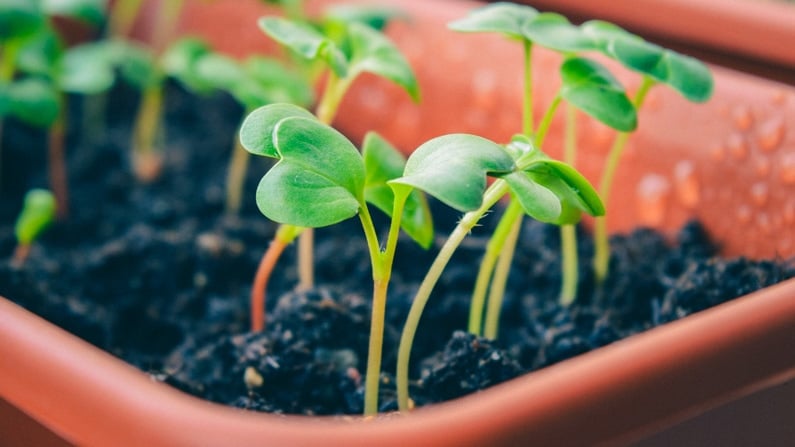
Why are leggy seedlings a problem?
They aren’t strong enough to withstand the sun and wind in your garden.
They’ll also be more susceptible to pests and diseases and may not produce well. So, it’s vital to prevent plant legginess by taking good care of them from the start.
They aren’t strong enough to withstand outdoor weather conditions.
So, what do leggy seedlings look like?
Leggy seedlings vs. normal
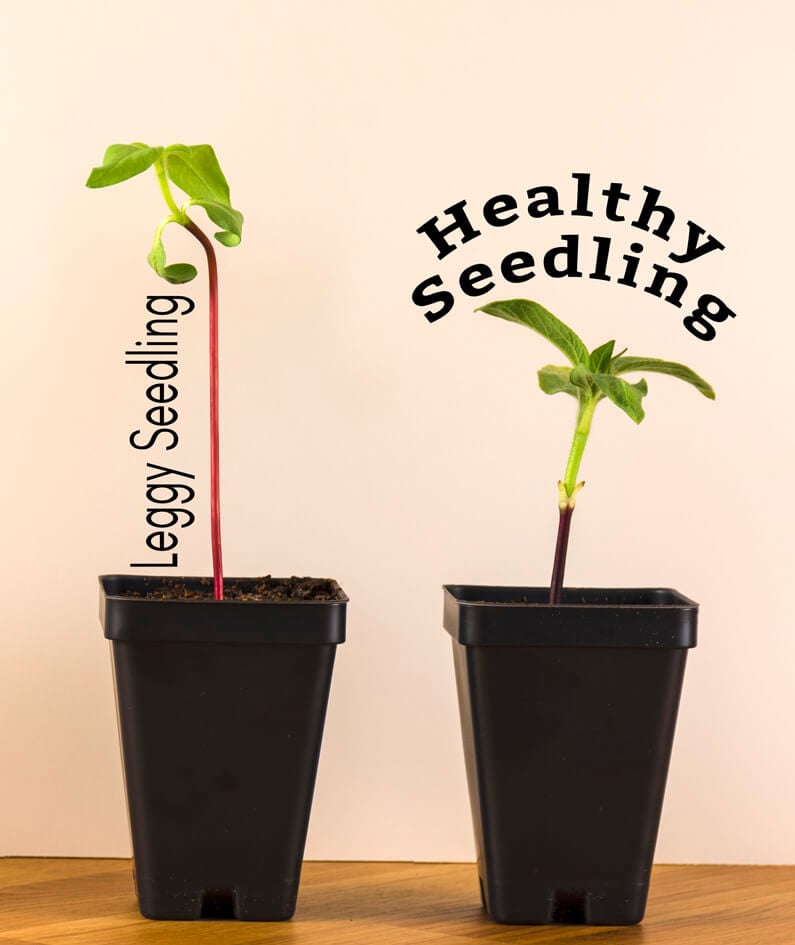
Before we discuss how to fix your seedlings, let’s talk about what causes leggy plants and how to prevent this common seed starting problem.
Why are my plants leggy?
1. A lack of light is the most common problem.
When your seedlings don’t have enough light, they reach up to get as much light as possible.
As they use up all their energy to reach what light there is, they get stretched out, and you end up with frail, spindly seedlings.
A common mistake many new gardeners make is starting seeds in a south-facing window.
“Just because a window seems bright from sunup to sundown does not mean it yields enough direct sunlight to grow plants.” —The Spruce
The weak sun in late winter and short days for northern gardeners make growing vigorous seedlings in a window nearly impossible.
Seedlings need 12-18 hours of strong light per day.
And they can’t get that from a windowsill, even if the sun is out.
The best way to give your seedlings the light they need is to grow them under supplemental lights.
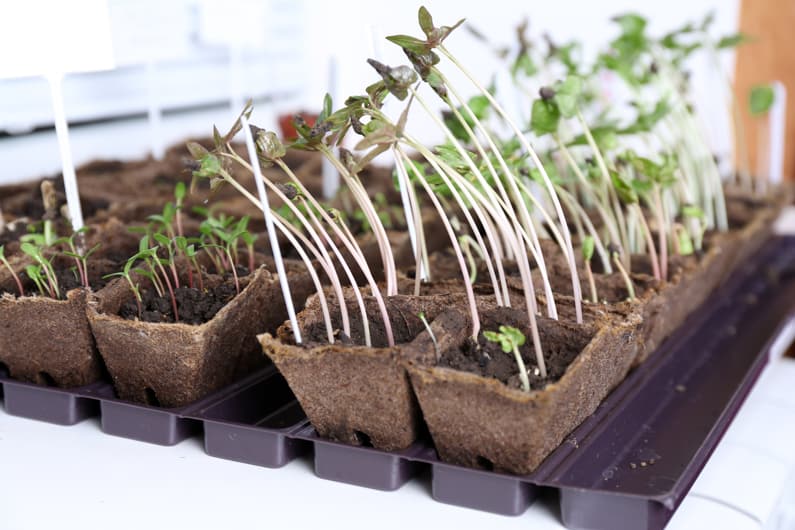
Related: FREE vegetable garden printables
Creating a seed starting setup is easy.
Check out my no-carpentry-required grow light plant stand for your seedlings. I’ve included a full list of supplies and instructions.
And as a bonus, you can download a free set of seed-starting shelf plans that’ll get you up and running in no time!
How can I have leggy seedlings under grow lights?
If you’re already growing your seedlings under lights, and they’ve gotten leggy, make sure to put the lights as close to your plants as possible without burning them.
If you’re using fluorescent lights, and your seedlings are stretching, it’s possible that your bulbs are too old and not putting out enough light.
The best practice is to replace your fluorescent light bulbs every few years.
BONUS: As a bonus for joining my weekly newsletter, download a free set of plant stand plans and get your seed starting setup built in an afternoon.
2. Crowding is a problem.
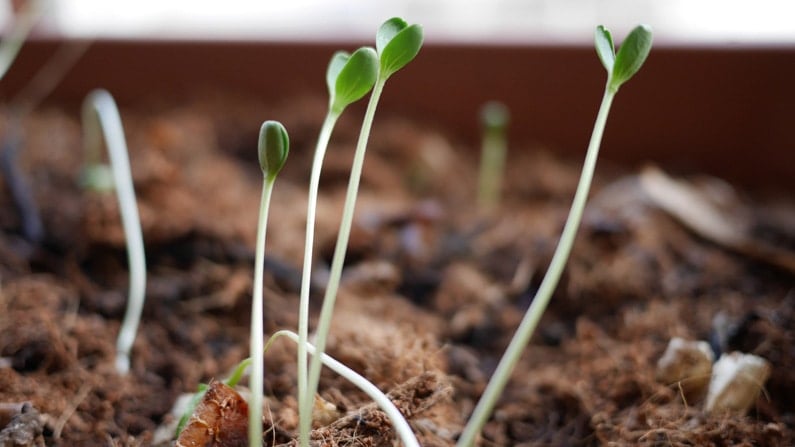
Correct spacing is important. When seedlings grow too close together, they don’t get enough light because they shade each other out.
This forces them to grow taller to compete for the light, and they end up getting leggy.
You can prevent this by thinning out your seedlings when the first leaves appear.
If your seedlings suffer from overcrowding, plan to use larger containers next time and space them farther apart from the start.
Pro tip: Take your seedling trays off the heat mat once your seeds have sprouted.
3. High heat can cause seed starting issues, including legginess.
Heat mats are a great way to germinate seeds faster. But don’t use them after your seeds have germinated unless you’re growing your seedlings in a cold room.
Some seeds require warm soil to germinate well.
But many seedlings will have a rapid growth spurt and get leggy when they’re kept too warm.
So, germinate your seeds at the temperature range recommended on the packet, and then take your seedlings off the heat mat once your seeds have sprouted.
4. Stagnant air (lack of wind) can contribute to legginess.
Seeds that germinate outside get the benefit of being strengthened by the wind.
As the wind blows them around, they get a little workout and grow stronger so they can withstand the wind without breaking.
But seedlings grown indoors don’t get that benefit.
So, how can you create wind for your seedlings?
Use an oscillating fan.
Think of a fan as strength training for your seedlings!
It mimics the windy conditions they’ll face outside. And gives you strong seedlings.
A fan will also help keep the surface of your soil drier, which helps cut down on things like damping off and mold growth.
I use a fan clamped to a metal shelf opposite my grow light setup. You can check out my seed starting setup and get free plans to set up your own (no carpentry required).
Prices last updated on 2025-07-09 at 22:16
You can brush your seedlings several times a day to strengthen them, but I’ve found that using a fan is just as effective and more convenient if you’re not home all day.
5. Dry soil can cause legginess.
If you let your potting mix dry out too much when your seedlings are young, it can cause them to get leggy.
Dry soil stops the plants from getting the nutrients they need to grow well.
Keep your soil evenly moist until your seedlings get their first leaves and are growing strong.
At that point, it’s fine to let the soil dry out in between waterings as long as your seedlings don’t wilt dramatically. This can help harden them off and lessen transplant shock when it’s time to plant them in your garden.
But when they’re young, keep the soil moist.
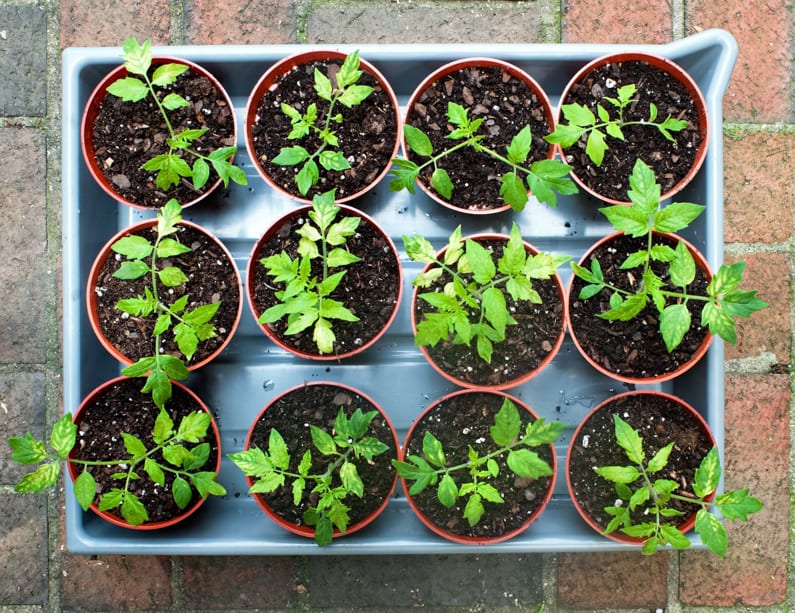
How to prevent leggy seedlings: advice from a gardening expert
- Give them enough light from a strong light source, like a shop light. The next time you start seedlings, make sure you do it under artificial lights with ventilation.
- Keep them moving. A good light stand setup equipped with a fan will promote plant health and stronger growth.
- Don’t overheat them. If you’re using a heat mat to germinate your seeds, move your trays off the heat once most of the seeds have sprouted.
- Water properly. How often you should water your seedlings depends on how fast they dry out. Keep the soil evenly moist until they get their first set of true leaves.
- Be vigilant. Check your seedlings every day. If they’re getting enough light but are leggy, it’s time to pot them up to a larger container because they’re crowded.
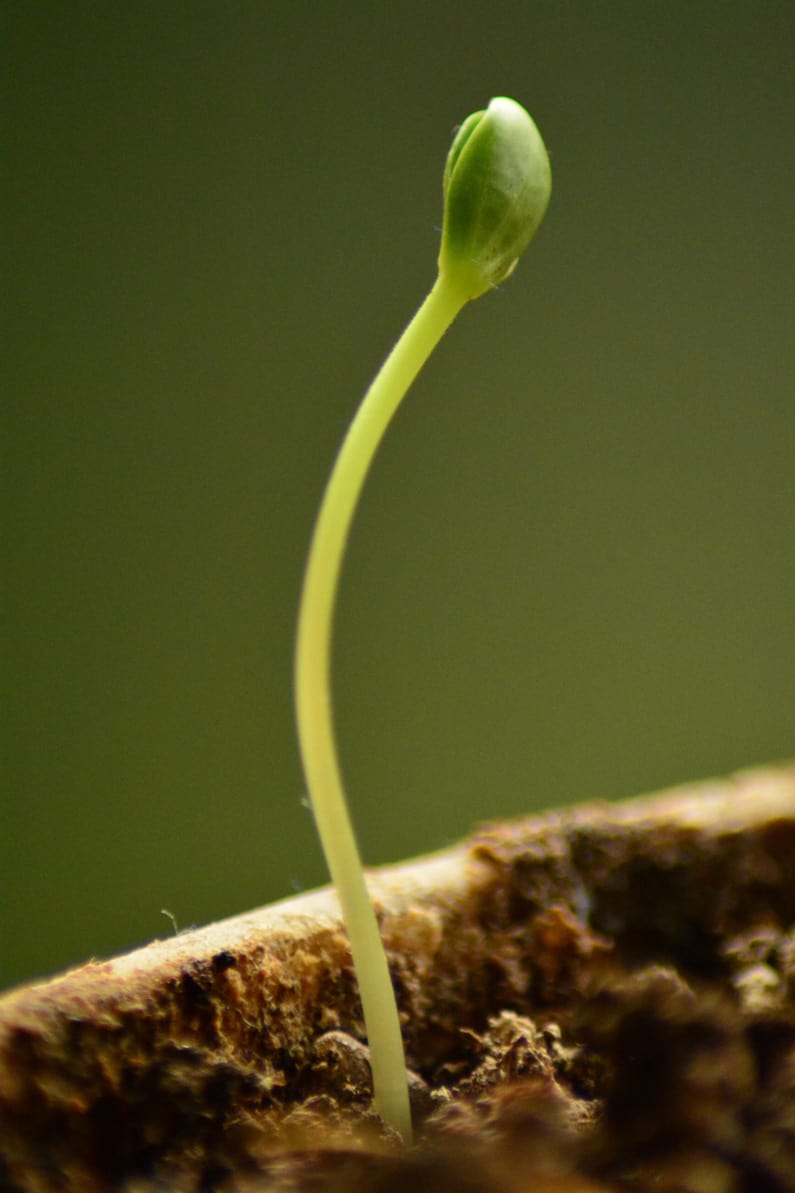
How do I know if my seedlings are too leggy?
Should you scrap this batch of seedlings and start over, or try to rescue them? It depends.
Can leggy seedlings recover?
Here are a few things to consider when deciding if you should try to save them:
- Are these seeds the only ones you have? If so, it makes sense to try to salvage them.
- Where are you in the season? You’ll miss your planting window if it’s late in the season and you don’t have more time to start seeds. So, it makes sense to try to save them. Especially if you’re growing your own food!
- How leggy are they? If you’ve caught them early enough, you might be able to save them.
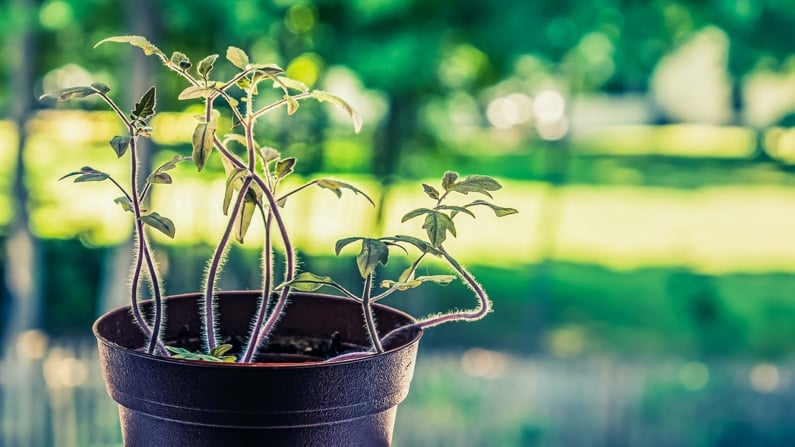
At what point are seedlings beyond saving?
Sometimes, it’s heartbreaking, especially when your favorite tomato seedlings get leggy, but it may be better to cut your losses.
Here’s what to look for when deciding if a seedling is too leggy to save:
- The stem is limp, and they’re falling over. It’s better to start over if they’ve gotten this leggy and weak.
- The distance between the soil and the first set of leaves is more than two or three inches.
- The distance between the sets of leaves is an inch and a half or more.
If it’s early enough in the season, and you’re not sure if you can rescue your seedlings, it’s best to replant. This is especially true for quick-growing crops like lettuce.
Watch a video from Cal Oke’s channel about fixing legginess:
How to fix leggy seedlings
- Make sure they’re getting enough hours of light. If you don’t have a grow light stand, consider building one. I have plans for a DIY grow light stand that can be put together in a few hours.
If you have a cold frame, consider moving your seedlings to it. You may need to shade them for a few days as they acclimate to the extra light in the cold frame.
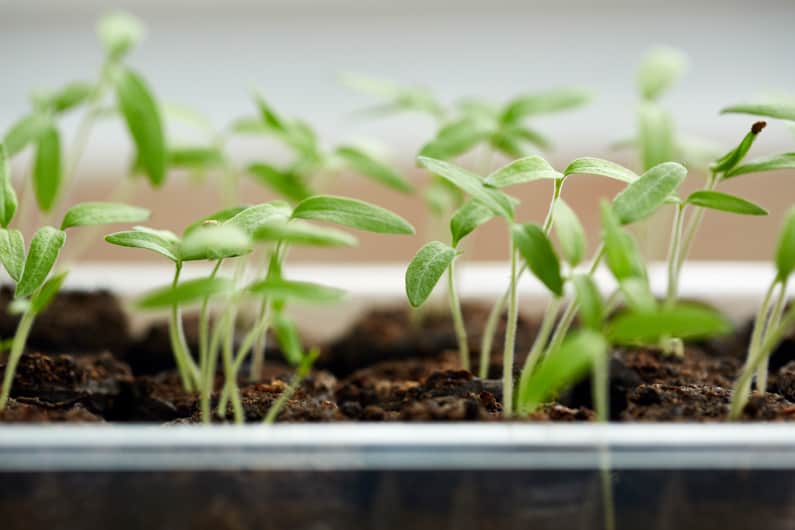
- If they’re crowded, thin them out. You should have only one plant per cell or pot. If you’ve grown seedlings in a flat, and they’ve gotten leggy, transplant them to new containers that keep them farther apart.
- Plant them deeper. You can successfully do this with leggy tomatoes, eggplant, peppers, and basil. These plants are all able to grow roots along their stems.
- Plant the leggy seedling in a deeper pot.
- Bury the stem up to the first set of leaves.
- The new roots that develop will build up the plant’s root system.
- Keep the air moving around your plants. Put a fan next to your seedlings. Set it on a timer, so they get wind for a few hours each day. Or, brush the tops of your plants several times per day.
- You can pinch back some seedlings to promote bushier growth.
Some seedlings respond well to pinching off the top group of true leaves. This forces them to branch out and grow more leaves.- Do pinch annuals such as coleus, cosmos, impatiens, scented geraniums, marigolds, salvia, snapdragons, petunias, and zinnias. Herbs like basil, tarragon, thyme, and sage also respond well to pinching.
- But do not pinch campanula, cockscomb, delphinium, dill, stock, larkspur, and most sunflowers.
Frequently asked questions about leggy seedlings
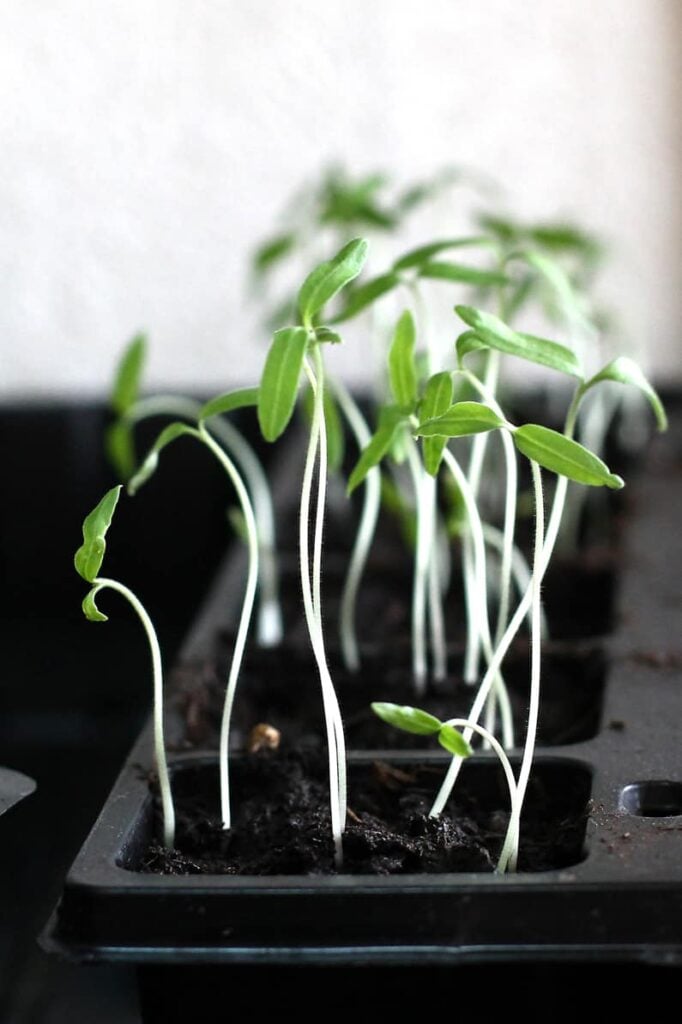
What is a leggy plant?
A leggy plant has elongated and lanky stems. This problem is common with indoor plants, as they often don’t receive enough sunlight. It can also refer to a plant that doesn’t have enough branches and lacks fullness. You can correct some plants that have gotten leggy by cutting them or “pinching” them back and providing them with enough light.
Are leggy seedlings bad?
Yes. When you start plants from seed, you want them to grow as strong and stocky as possible. In general, leggy seedlings happen when the plant doesn’t get enough light. The stem will stretch out as it tries to find light from the sun. This is why giving your seedlings plenty of light from the start is important.
Is legginess always caused by light?
No. It can be caused by factors other than not enough light. Legginess can be caused by crowding, high heat, stagnant air from a lack of wind, and dry soil.
How much light should seedlings get?
Seedlings should get 12-16 hours of strong light per day. Seedlings need a minimum of 3,000 lumens per square foot.
Why are my seedlings falling over?
They may not be getting enough light. Make sure they’re getting 12-16 hours of bright light per day. They may be getting too much water. High temperatures could be stressing them, causing them to bolt and fall over. Make sure they’re not too hot. Check the soil to make sure it’s not soggy or waterlogged; if it is, allow it to dry out before watering again. Soggy soil can lead to damping off. If your plants are outside and falling over, they may not have been hardened off adequately before you planted them.
How do you strengthen leggy seedlings?
Leggy seedlings are a common problem for gardeners, but there are a few things you can do to help strengthen them.
Another way to help leggy seedlings is to give them more light. If they are getting long and spindly, it means they aren’t getting enough light. Try moving them to a sunnier spot, or using grow lights. If your seedlings have multiple sets of leaves, you can pinch them back. But the best way to strengthen leggy seedlings you’re growing indoors is to create wind by running a fan on them.
Can you bury leggy seedlings deeper?
You can bury leggy tomatoes, eggplant, pepper, and basil seedlings deeper. If they have only one set of leaves, you can bury the stem up to the first group of leaves. If they have more than one set of leaves, remove their lower leaves and bury them in a taller pot up to their top leaves.
How can I keep my seedlings from drying out?
Check your seedlings every day. Once the top one-half to one inch of soil is dry, it’s time to water them. Bottom watering the roots is the best way to water your seedlings and prevent diseases from taking hold.
Your turn: tell me about your leggy seedlings
Did you learn anything new about preventing legginess or fixing leggy seedlings?
Let me know in a comment below!






This is my first time starting from seeds and i did exactly what you said not to do… now that i have read your article… im hoping to be able to salvage most of my seedlings.
Thank you for your article, it was very helpful
Dina G.
Hi Dina,
I’m glad you found the article helpful. I hope you can save your seedlings!
Thanks for sharing your great tips on preventing leggy seedlings! I often end up pinching back and/or re-potting and planting them deeper.
Thanks for your wisdom on leggy plants! I hope to save mine and work on your grow stand for next year.
Hi Carol,
You’re welcome! I’m happy to hear you found the article helpful.🙂
Good article, learned a lot. I’ve been known to just throw them all away so it’s great to know I can report them. Thanks for the info.
Hi Sheryl,
I’m so glad this helped you!
Your article on leggy seedlings have really helped me so much as a first time seed grower. Thank you so much!
Hey Alice,
I’m happy to hear you found it helpful! Happy seed starting!
Wow! This was very helpful! I had just planted my seeds when I found your site. How fortunate for me! I am using a fan and have lowered my light source to just above their pretty little heads. I think I will have a better harvest this year. Thank you!
Marci,
You are so welcome! The fan was a seed-starting game-changer for me! Here’s to a great gardening year!🎉
I have a perplexing problem. I am trying to grow some Primrose (Primula) seed and it says they have to be in the dark to germinate. So I covered them with foil and now I see a few leggy seeds popping up. So what should I do? If the un-sprouted ones need darkness and the leggy seedlings need the sunlight, how do I go about satisfying everybody!!? I’m planning to just take off the foil and hope the other ones come up, but I’m not sure if this is the answer. Thank you for any advice you can give me.
Hi Pauline,
I’d remove the foil. As soon as you start to see some seedlings emerge, that’s the time to remove the cover.
Thank you. I think that would be best, too, just needed some encouragement.
I have so many leggy seedlings! If I pull them and start over, can I use the same soil and peat pot? I bought a fan today and have them under my LED grow light.
I am also wondering if I should take my peppers off the heat mat now that they have sprouted the first two leaves, not true leaves. Thank you!
Hi Vivian,
Yes, you can use the same soil as long as it doesn’t have mold growing on it. Peppers like a bit more heat than other plants, so it’s probably ok to keep them on the heat mat a while longer.
Good morning from Hillsborough, N.B. Canada. I have a grow light, a heated porch. No fan but will try this– wondering if i need more light or nutrients.
Is there a way to salvage tall, (9 inches), spindly cucumber seedlings?
You may be able to save them if you have tall pots you can bury them in. If you do, bury them up to the first set of true leaves.
I’m growing a variety of annual flowers. I have the seed trays in a mini temporary green house with a zipper plastic clear cover. The seeds are popping up and it’s warm and muggy in the greenhouses. Should I open them up so it’s not so warm and muggy in there and provide some air flow (maybe even a fan as you suggested)?
Hi Lisa,
Yes! Air circulation will help reduce the chance of disease, such as damping off.
I just started a bunch of seeds for the first time ever, and almost all of them are leggy…I didn’t even know it was a bad thing. I was wondering when they were going to start growing out instead of up, though. Hopefully I can save them. Luckily I already had a box, nice lights, and a nice fan specifically for grow boxes laying around.
Thank you for this very helpful article!!
I have leggy squash seedlings I started indoors, and I think it’s time to harden them off to get them outside. But I have 31 🤭
Moving that many in and out is trouble. I have them in a small bathroom with a fan so I’ve been opening the window to let the outside air in to slowly start hardening them off. Do you have any tips to help harden off leggy squash seedlings that I can’t give up on 😹
Hi Emma,
The fan and air movement will help some, but to really harden off seedlings you need to gradually expose them to the same conditions they’ll experience outside. There are a few ways you can do that.
1) You can move them in and out over the course of a week, exposing them to more and more sunlight – which is a PITA.
2) You can use a cold frame and several layers of shade cloth — removing a layer of shade cloth every couple of days – this means you won’t need to bring them in at night unless there’s a severe cold snap predicted.
3) Use Wall O’Waters. Harden them off for 2-3 days and then plant them in Wall O-Waters. I’ve found that seedlings don’t need to be hardened off a full week before planting them in Wall O’ Waters.
Thank you! I’ll try again using your suggestions. My poor starters were so sad. I love your ideas and fixes
Thank you so much. This was my first year planting so have no grow lights.
Had started petunias but they did much better and are more bushy than tall.
Can you “pinch” morning glories?
Abby,
Yes, you can pinch your morning glories. By pinching the tips of the plant, you can help control leggy growth and encourage them to bush out. Once they mature, if you don’t want the plant to reseed, pinch off spent flowers before they turn into seedpods. This’ll also encourage the plant to keep producing more flowers.
I hope that helps!